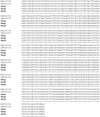Development and Evaluation of a Semi-Nested PCR Method Based on the 18S ribosomal RNA Gene for the Detection of Babesia aktasi Infections in Goats
- PMID: 39453058
- PMCID: PMC11511400
- DOI: 10.3390/vetsci11100466
Development and Evaluation of a Semi-Nested PCR Method Based on the 18S ribosomal RNA Gene for the Detection of Babesia aktasi Infections in Goats
Abstract
We developed and evaluated a semi-nested PCR assay for the detection of Babesia aktasi infection in goats based on the sequence of the B. aktasi 18S ribosomal RNA gene. Following in silico screening, the specificity of the primers was assessed using reference DNA samples, including B. ovis, B. motasi, B. crassa, B. venatorum, B. divergens, B. capreoli, Theileria ovis, and T. annulata. To determine the sensitivity of the method, blood infected with 2% parasitemia of B. aktasi was diluted to 10-fold serial dilutions. The method specifically amplified a 438 bp fragment of B. aktasi DNA, but did not demonstrate cross-amplification with the other hemoparasites tested. The sensitivity assay indicated that this PCR method was able to detect infection at a dilution of 10-8 of 2% parasitemia (0.074 parasites/200 µL). Ninety-seven blood samples collected from goats were used to analyze for B. aktasi, and the infection was detected in 18.5% of the goats. Additionally, the method was also applied to 44 field DNA samples that were detected to be positive for B. aktasi by reverse line blotting (RLB), and showed 84.1% agreement. The findings revealed that newly developed semi-nested PCR can detect B. aktasi infections in goats with high sensitivity and specificity.
Keywords: 18S ribosomal RNA gene; Babesia aktasi; goats; semi-nested PCR; specific primers.
Conflict of interest statement
The authors declare that they have no conflicts of interest.
Figures




Similar articles
-
Small Ruminant Piroplasmosis: High Prevalence of Babesia aktasi n. sp. in Goats in Türkiye.Pathogens. 2023 Mar 26;12(4):514. doi: 10.3390/pathogens12040514. Pathogens. 2023. PMID: 37111400 Free PMC article.
-
Development of a polymerase chain reaction method for diagnosis of Babesia ovis infection in sheep and goats.Vet Parasitol. 2005 Nov 5;133(4):277-81. doi: 10.1016/j.vetpar.2005.05.057. Vet Parasitol. 2005. PMID: 16043298
-
Experimental infection of non-immunosuppressed and immunosuppressed goats reveals differential pathogenesis of Babesia aktasi n. sp.Front Cell Infect Microbiol. 2023 Nov 2;13:1277956. doi: 10.3389/fcimb.2023.1277956. eCollection 2023. Front Cell Infect Microbiol. 2023. PMID: 38029260 Free PMC article.
-
Discovery of a Novel Species Infecting Goats: Morphological and Molecular Characterization of Babesia aktasi n. sp.Pathogens. 2023 Jan 10;12(1):113. doi: 10.3390/pathogens12010113. Pathogens. 2023. PMID: 36678461 Free PMC article.
-
Simultaneous detection and differentiation of Theileria and Babesia parasites infecting small ruminants by reverse line blotting.Parasitol Res. 2004 Feb;92(3):189-96. doi: 10.1007/s00436-003-0980-9. Epub 2003 Dec 3. Parasitol Res. 2004. PMID: 14652747
References
-
- Schnittger L., Ganzinelli S., Bhoora R., Omondi D., Nijhof A.M., Florin-Christensen M. The Piroplasmida Babesia, Cytauxzoon, and Theileria in farm and companion animals: Species compilation, molecular phylogeny, and evolutionary insights. Parasitol Res. 2022;121:1207–1245. doi: 10.1007/s00436-022-07424-8. - DOI - PubMed
-
- Iqbal F., Fatima M., Shahnawaz S., Naeem M., Shaikh R.S., Ali M., Shaikh A.S., Aktas M. A Study on the determination of risk factors associated with babesiosis and prevalence of Babesia sp., by PCR amplification, in small ruminants from Southern Punjab (Pakistan) Parasite J. Société Française Parasitol. 2011;18:229. - PMC - PubMed
Grants and funding
LinkOut - more resources
Full Text Sources

